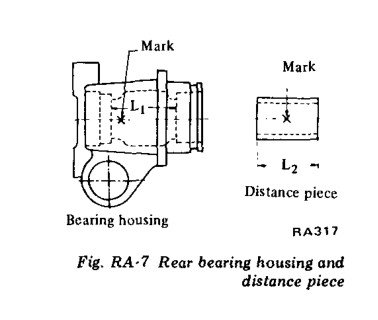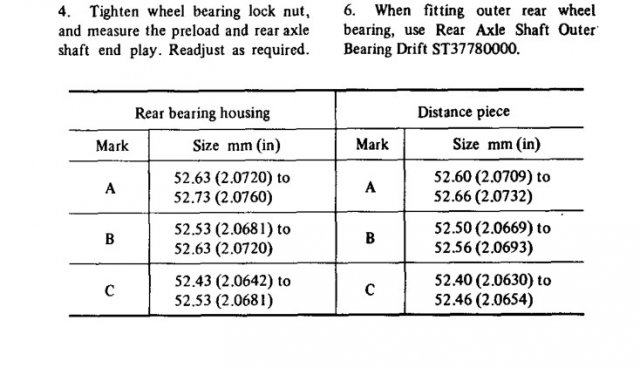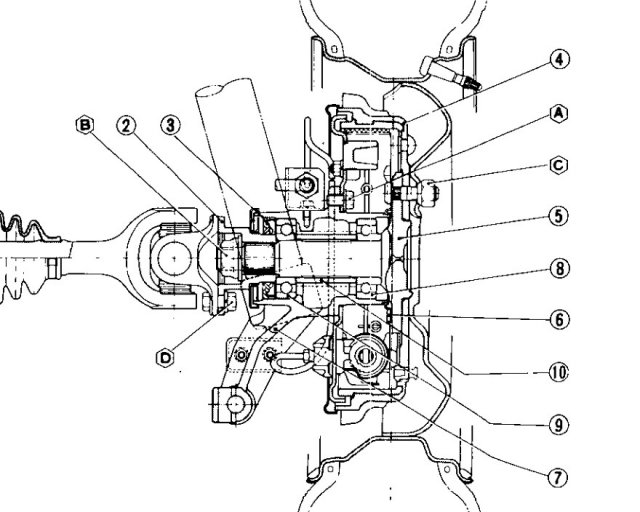
NewZed
Members-
Posts
6692 -
Joined
-
Last visited
-
Days Won
71
Content Type
Profiles
Forums
Blogs
Events
Gallery
Downloads
Store
Everything posted by NewZed
-
Toying with the idea of starting a 240z restoration but...
NewZed replied to NickA's topic in S30 Series - 240z, 260z, 280z
The main purpose of Hybridz, as I understand it, is to discuss ways to add pep. Have you browsed through some of the threads? Check out the FAQ's section. Rebuilding an L24 wouldn't be high on anyone's list of ways to add pep though. What does TL;DR stand for? -
FS5W71B - Item that might be overlooked on rebuild often?
NewZed replied to inline6's topic in Drivetrain
I had one that leaked through the clutch fork pivot pin (with the ball on the end). The threads are through the front cover. If you took the pin out and didn't seal the threads when you re-installed that could be your source. -
Here's a link to classiczcars.com that might work for you. Not really easy though. http://www.classiczcars.com/forums/content/201-honda-wiper-motor-upgrade-240z.html Another option is Philbin in Portland, OR. They'll clean up the motor and replace any broken parts for a very reasonable cost. At least they did for me a few years ago. http://www.philbingroup.com/
-
You need to measure fuel pressure after you shut the engine down and before you start to know if the fuel rail is draining. If the rail is at zero when you hit the starter the engine will just keep cranking until the rial fills and re-pressurizes. My 76 280Z has not had a cold start valve for the last few years. I went out last week after it had sat for a few days in the garage and it fired right up after about five revolutions. When I had an FPR that leaked down it would take longer, although not as bad as you're describing. You might also have weak spark. Check the grounds on your ignitor (power transformer) and its mounting bracket. During starting spark is weaker since battery power is sucked up by the starter. If you have a weak transformer it might cause starting problems. I had an ignition module once that would only start the engine with starting fluid but ran okay once the engine started.
-
Be aware that if you go to a typical parts store and ask for 280ZXT alternator you'll most likely get a 60 amp unit.
-
Have you tried your local Nissan dealer?
-
P90 L28ET exhaust/ intake manifold gasket preference
NewZed replied to BMAC's topic in S130 Series - 280ZX
I wonder if these sellers, and maybe Nissan too, don't have multiple sources for what they sell under their names. I couldn't even find the Beck/Arnley gasket on their e-catalog (which they seem to think is fantastic) unless I had the part number first, 037-3936, and the picture may or may not be correct. But it doesn't show the metal crush ring. Looks like paper too. http://www.beckcatalog.com/# http://www.beckarnley.com/beckarnleycatalog.html Looks better on Amazon. Same company, different picture - http://www.amazon.com/Beck-Arnley-037-3936-Exhaust-Manifold/dp/B000CAVLYC Looks like no way to tell what you're getting, over the internet. p.s. Is "graphite" really the material used on some of the gaskets or did someone just give it that name because it's black and looks fibrous, like graphite fiber composites? Edit - some of the parts people refer might just be NLA. There's a 1978 Beck/Arnley 037-3951 gasket, wholesaler closeout, on Rockauto that does not come up on BeckArnley's catalog (above). The "good" gaskets may not be available anymore as normal stock items, only NOS. -
Strange noises in the engine bay. A/C Compressor? (See video)
NewZed replied to Connor280ZX's topic in S130 Series - 280ZX
It's not uncommon for the adjustment idler pulley bearing to go bad on the S30's. I'm not familiar with what the S130's use for belt adjustment. I also don't know what compressor bearing failure sounds like when you blend R134 with with R12 and its lubricants. From what I've read the lubricant used in R12 is incompatible with R134. If you put enough R134 in, the R12 lubricant will separate and the compressor bearings will fail. Could be what's happening to yours. -
P90 L28ET exhaust/ intake manifold gasket preference
NewZed replied to BMAC's topic in S130 Series - 280ZX
I'll bet they're garbage... Are they more expensive Fel-Pro? The Fel-Pro gasket on my engine now is the paper/cardboard style. Weird that you would have the sandwich type from Fel-Pro. And they only show one model number on their site - http://fme-cat.com/overlays/part-detail.aspx?brand=FL&PartNumber=MS%2091034&pt=Intake%20and%20Exhaust%20Manifold%20Combination%20Gasket&lu=1982%20NISSAN%20280ZX&vin=#.UpbIQiff_Fw http://fme-cat.com/Application.aspx?year=1982&make=NISSAN&model=280ZX&cat=Engine&subcat=Gaskets%20and%20Sealing%20Systems&brand=Fel-Pro -
P90 L28ET exhaust/ intake manifold gasket preference
NewZed replied to BMAC's topic in S130 Series - 280ZX
The MSA and Victor Reinz gaskets are three layer - polymer on each side of thin steel. I don't know what the polymer is. It's not paper though. Or graphite. I've had both MSA and VR and would bet that MSA just resells Victor Reinz, they look identical and fit the same. Victor Reinz is available on RockAuto.com -
Not to kill a sale but, weirdly enough, your local Nissan dealer might be able to get one. Part #10, three part numbers, might be A, B, and C. http://www.carpartsmanual.com/datsunS30/DatsunZIndex/Axle/RearAxleDriveShaft/tabid/1730/Default.aspx http://www.courtesyparts.com/spacer-bea-p-359070.html
-
There's room for a mirror. Use your left hand to compensate for seeing in reverse.
-
-
Electrical issues with relays while ignition in LOCK
NewZed replied to Trentomobol's topic in S30 Series - 240z, 260z, 280z
You might consider cutting your losses (time) and re-installing the old Hazard switch. Looks like you've created a new problem with the Hazard switch replacement. -
Electrical issues with relays while ignition in LOCK
NewZed replied to Trentomobol's topic in S30 Series - 240z, 260z, 280z
ALL RELAYS PULSE ON AND OFF. What would cause a pulsing? Flashers. Check those two circuits for shorts. -
Electrical issues with relays while ignition in LOCK
NewZed replied to Trentomobol's topic in S30 Series - 240z, 260z, 280z
Problems -
What's cylinder pressure now? Did you clean a lot of carbon from the piston and combustion chamber? Curious. I've seen signs that the intake valves were getting cleaner on my old engine, that had obviously sat for many years before I got it. They were cleaner when I finally took it out than when I changed the manifold gasket, after about 20,000 more miles. I had seen the same as you and wondered about cleaning up the backs of the valves. They were nasty looking. To Xnke's suggestion, modern gas and hard driving to get lots of flushing on the back of the valve might be the way to go. A good reason to go have some fun. You're cleaning your valves.
-
Which method, three were mentioned? Seafoam, water or walnut shells.
-
Rear Wheel Stub Axle Play - Help Needed
NewZed replied to Wheeler's topic in Brakes, Wheels, Suspension and Chassis
Thanks for correcting me. With that in mind, and a little more digging in the FSM, you'll find that all of the information needed is in the Rear Axle chapter. L1 and L2 in the drawing, numbers in the chart. With the measurement tool of your choice you don't need the letters anymore. Not to argue, but it looks like with tolerances there's a lot of overlap, but the goal (blueprint) might be to have the strut housing ~.010 - .020" bigger than the distance piece. Just looking at the numbers. Really though, they look pretty sloppy and essentially just centered. Maybe those are just starting points and the "adjustment" procedure that Nissan never describes, to get preload and end play, is what sets the final distance. If adjustment is nut torque then there's some compression of the distance piece, If they mean disassembly and adjusting piece distance then there's more labor involved. -
Rear Wheel Stub Axle Play - Help Needed
NewZed replied to Wheeler's topic in Brakes, Wheels, Suspension and Chassis
I made a comment earlier about the bearing system being designed for hot running, but it's probably not that much of a factor in this case since all of the materials are similar. I had transmission countershaft bearings in mind, which are set on steel shafts in an aluminum housing. and preloaded for proper clearance when they heat up. The strut materials would all expand at close to the same rate. If you look at the attached drawing you'll see that the seating area for the outer races is in line with the inner races. I think that the distance spacer is meant to match that outer racing seat distance, to center the balls in the races when everything is assembled. You wouldn't want the balls riding on the sides of the races since the loads on them shift from side to side and up and down. If I was starting from scratch or "blueprinting" my struts I would measure that area, from outer race seat to outer race seat, on each strut and make the "distance piece" match it. That's where my logic takes me. There might be more to it. Edit - forgot to say that the inner and outer diameters of the distance piece probably aren't that critical as long as the ends are flat and parallel and offer a good seating area for the inner bearing races. When everything is compressed by the axle nut the two inner races and the piece essentially form a solid tube of steel. -
http://www.ebay.com/itm/Datsun-Z-240Z-260Z-280Z-New-Bracket-Brace-Differential-Nose-Support-Bar-69-78-/151170316498?pt=Motors_Car_Truck_Parts_Accessories&hash=item233273f8d2&vxp=mtr Don't really see any benefits over stock. But there it is. In retrospect I do remember seeing this, and noting that it is sold by DatsunPartsLLC, a guy of suspect credentials in the Z car field. But he has a lot of parts for sale.
-
SoCal: what is the reasonable price to weld 2 baddog frame rails?
NewZed replied to 9rider's topic in Fabrication / Welding
With the right surface prep an automotive adhesive might be better than welding or bolting, at least for portions of the new rails. Especially considering all of the surface area available, and stress distribution. One company's web site. There are others. Might have to register to see details. http://www.lord.com/products-and-solutions/adhesives.xml -
Did I properly delete the EGR and Evap canister?
NewZed replied to lcbusa1300's topic in S30 Series - 240z, 260z, 280z
The quickest way to check the coolant temp sensor is with a meter at the ECU connector. Does your friend have one and know how to use it? Three phillips head screws and you're in. Nobody can tell you over the web if the ECU is getting the right information. Have you opened up the 1980 Fuel Injection Guide yet, or the Factory Service Manual? They're on the internet and free. It looks like the only work you've done is to tear things apart and guess wrong in putting them back together, with no reading at all. Read up and catch up and some of your questions will be answered. There's not much anyone out here can do for you if you don't even know the basics. http://www.nicoclub.com/FSM/ Use the 1980 EFI guide it covers 1978 too - http://www.xenons130.com/reference.html -
Dang, I knew that one would show up if I said they didn't exist...



